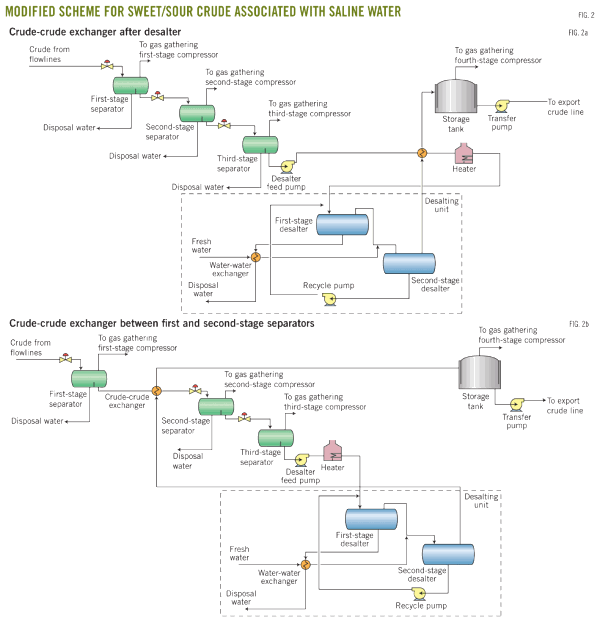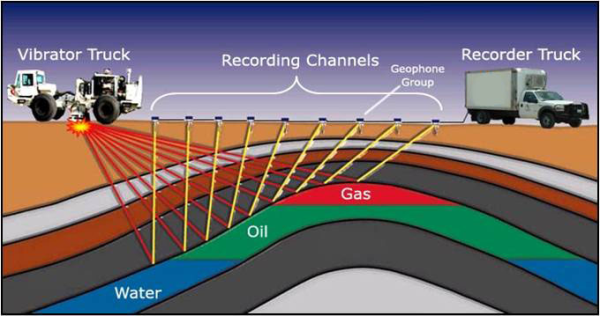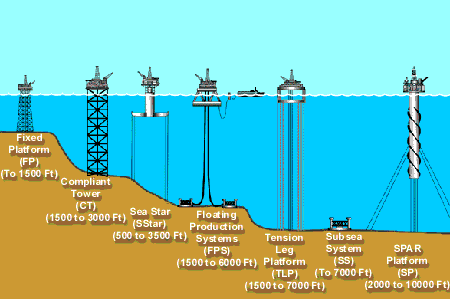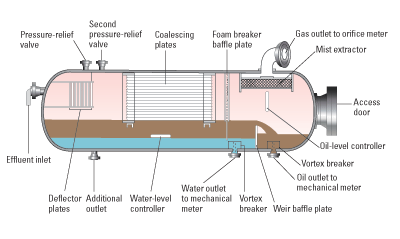The Basic Physics Behind Upstream Petroleum
Since the majority of Petroleum
Engineering focuses on the upstream
sector and can be broken down into several different categories it
would take a whole website of its own to explain the interdisciplinary
fields involved in upstream petroleum. This section will provide
techniques used in locating potential oil reservoirs, fundamentals of
drilling and production.
Petroleum Exploration with Geophysical
Surveys
Geophysical Surveys are
essential in exploration because they give an idea of the subsurface
features and the probability of hydrocarbon accumulation before
drilling for oil.
Seismic Survey:
Seismic
survey
is
the
most
productive
geophysical
methods
used
in
petroleum
exploration.
As shown in the diagram below, the vibrator truck releases vibrations into the ground. Once these vibrations reach the different rock layers the geophones record the time it takes the sound waves to refract off the different layers of rock.
Each refraction time is unique to the lithology. Thus, the Geophysicist can map out what the subsurface looks like.
As shown in the diagram below, the vibrator truck releases vibrations into the ground. Once these vibrations reach the different rock layers the geophones record the time it takes the sound waves to refract off the different layers of rock.
Each refraction time is unique to the lithology. Thus, the Geophysicist can map out what the subsurface looks like.
Drilling
Offshore
Drill Rigs
Production

Exploration
Exploration heavily involves geology
and geophysics. Even though the oil
and gas industry has the reputation of being environmentally
unfriendly, petroleum exploration is performed in clean and safe manner.
- Geophysical Surveys: Seismic Survey, magnetic survey
electromagnetic survey, gravity survey
- Aerial Photo graphs / Satellite images: imaging radar.
- Surface outcrops: geologists analyze uplifted surface outcrops to
determine the subsurface in the region.
These methods provide good
probability of hydrocarbon accumulation but drilling is the only
conclusive method in discovering oil.
Drilling
The majority of the the textbook physics is involved in Petroleum Drilling: The mechanics
of the drill rig, hydrolics, pulley systems etc.
Click the link below to view an educational drill
rig module created by The Advanced Energy
Consortium
Rig Animation
Drilling Methods
Drilling Methods
- Cable Tool (not applied today)
- Rotary Drilling (universal)
- Coil tube drilling (multilateral wells)
- Top drive (no rotary table or kelly)
- Bottom Hole Assembly (BHA)
- Conventional: (rotary table with kelly)
Production
Once the reservoir fluids come to the surface they first go through the
horizontal separator where gas comes out the top, oil comes out the
side and water comes out the bottom. Now that the fluids are
split up they undergo different processes. The gas will be
compressed, dehydrated, and liquefied then whether or not there
is a market for natural gas the gas will be piped to a refinery or it
will be reinjected into the reservoir for secondary recovery. The crude
will be further processed to remove other unwanted components then it
will be piped to a refinery. The water will be treated and reinjected
into the reservoir to help displace more oil.



